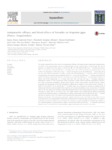Por favor, use este identificador para citar o enlazar este ítem:
http://www.alice.cnptia.embrapa.br/alice/handle/doc/1070034| Título: | Antiparasitic efficacy and blood effects of formalin on Arapaima gigas (Pisces: Arapaimidae). |
| Autor: | ANDRADE-PORTO, S. M.  AFFONSO, E. G.   KOCHHANN, D.   MALTA, J. C. O.   ROQUE, R.   ONO, E. A.   ARAÚJO, C. S. O.   TAVARES-DIAS, M.   |
| Afiliación: | SANNY MARIA ANDRADE-PORTO, UFAM; ELIZABETH GUSMÃO AFFONSO, INPA; DAIANI KOCHHANN, UVA; JOSÉ CELSO OLIVEIRA MALTA, INPA; ROSEMARY ROQUE, INPA; EDUARDO AKIFUMI ONO, INPA; CLEUSA SUZANA OLIVEIRA ARAÚJO, UEA; MARCOS TAVARES-DIAS, CPAF-AP. |
| Año: | 2017 |
| Referencia: | Aquaculture, v. 479, p. 38-44, Oct. 2017. |
| Descripción: | This study evaluated the in vitro and in vivo antiparasitic efficacy of formalin against Dawestrema cycloancistrium, the effects on the physiological response of Arapaima gigas and the residual action on fish muscle after 96h of exposure. As regards the in vitro assay, 0, 22, 44, 66, 88, 110, 330, 660 and 880 mg L-1 formalin were tested. After 1h of exposure to 660 and 880 mg L-1 formalin, there was a 100% mortality of D. cycloancistrium as well as after 2h of exposure at 330 and 110 mg L-1 and 3h of exposure at 44, 66 and 88 mg L-1. Concerning the in vivo test, when fish were exposed to formalin at 0, 220, 330, 440 and 550 mg L-1, there was 100% survival at all concentrations and exposure times evaluated. Baths of 1h with 440 and 550 mg L-1 formalin showed 93.3% and 99.3% efficacy respectively. However, the baths of 12h with 55 and 66 mg L-1 formalin had the efficacy of 44.5% and 55.5% respectively. In 1h baths with 220, 330, 440 and 550 mg L-1 formalin, hematocrit, hemoglobin, number of total erythrocytes, mean corpuscular volume, mean corpuscular hemoglobin concentration, mean corpuscular hemoglobin, plasma glucose levels, cortisol, total proteins, chloride, calcium, sodium, potassium and magnesium of the fish presented no differences in relation to the control values. However, in baths of 12h with 33, 44, 55 and 66 mg L-1 formalin, there was a decrease in hematocrit, plasma levels of calcium and chloride, and increased levels of glucose and cortisol, depending on the concentration of formalin used. In the fish muscle, the formalin residue decreased after 96h in all concentrations and periods evaluated, returning to values close to the control ones. The results indicate that formalin had its efficacy successfully proved in the treatment against D. cycloancistrium at higher concentrations such as 440 and 550 mg L-1 formalin and shorter exposure time (1h) without compromising fish homeostasis and consumer food safety. Statement of relevance: The manuscript represents original research on use of formalin in vitro and in vivo for treating infection by monogenoidean Dawestrema cycloancistrium in Arapaima gigas, the giant fish from Amazon. In the fish, muscle the residue levels of formalin after exposure was also investigated. Formalin have efficacy in the treatment against D. cycloancistrium at higher concentrations (440 and 550 mg.L-1) of formalin and shorter exposure time (1h) and without compromising A. gigas homeostasis and consumer food safety. |
| Thesagro: | Peixe de água doce Parasito Hematologia Tratamento Fisiologia |
| NAL Thesaurus: | Freshwater fish Hematology Physiology |
| Palabras clave: | Treatment Parasite |
| Tipo de Material: | Artigo de periódico |
| Acceso: | openAccess |
| Aparece en las colecciones: | Artigo em periódico indexado (CPAF-AP)  |
Ficheros en este ítem:
| Fichero | Descripción | Tamaño | Formato | |
|---|---|---|---|---|
| CPAFAP2017Antiparasiticefficacyandblood.pdf | 242,29 kB | Adobe PDF |  Visualizar/Abrir |









